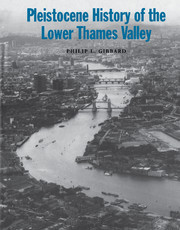Book contents
- Frontmatter
- Contents
- Preface
- 1 Introduction
- 2 Lithostratigraphy
- 3 Comparison of the pebble lithological composition of the gravel members
- 4 Sedimentary structures and depositional environments
- 5 Vertebrate faunal assemblages
- 6 Palaeobotany and biostratigraphy
- 7 Palaeolithic artefact assemblages
- 8 Palaeogeographical evolution of the Lower Thames Valley
- 9 Correlation with neighbouring areas
- References
- Appendix 1 Pebble counts from high-level gravels in the Epping Forest area
- Appendix 2 Pebble counts from the Lower Thames region
- Index
4 - Sedimentary structures and depositional environments
Published online by Cambridge University Press: 04 August 2010
- Frontmatter
- Contents
- Preface
- 1 Introduction
- 2 Lithostratigraphy
- 3 Comparison of the pebble lithological composition of the gravel members
- 4 Sedimentary structures and depositional environments
- 5 Vertebrate faunal assemblages
- 6 Palaeobotany and biostratigraphy
- 7 Palaeolithic artefact assemblages
- 8 Palaeogeographical evolution of the Lower Thames Valley
- 9 Correlation with neighbouring areas
- References
- Appendix 1 Pebble counts from high-level gravels in the Epping Forest area
- Appendix 2 Pebble counts from the Lower Thames region
- Index
Summary
Gravel units
All the units of waterlain, sorted gravel and sand repeatedly show suites of sedimentary structures that indicate deposition under broadly similar fluviatile conditions throughout the area. It is therefore possible, in general terms, to discuss the sedimentary sequences of deposits together.
Previous investigations of the sedimentary structures of the gravel units have been presented in association with descriptions of fossiliferous fine sediment channel fills in gravels in neighbouring areas. For various reasons these have concluded that the sediments originated in a cold climate river depositional environment. However, detailed facies assemblage studies (e.g. Corner, 1975; Bryant, 1983a, b; Dawson, 1985; Dawson & Bryant, 1987) have not been presented for the Lower Thames region. In the same way as in the Middle Thames area (Gibbard, 1985), a generalised facies description is presented here for the gravel members, based on the sequences examined during this study. The sediments can be assigned to the braided or so-called wandering gravel river environment on the basis of facies models developed by Miall (1977, 1978). Individual gravel members may show minor deviations from the scheme. In addition, the facies descriptions can only be applied to those units that are exposed in large sections where the lateral and vertical relationships can unequivocally be observed.
- Type
- Chapter
- Information
- Pleistocene History of the Lower Thames Valley , pp. 123 - 130Publisher: Cambridge University PressPrint publication year: 1994

